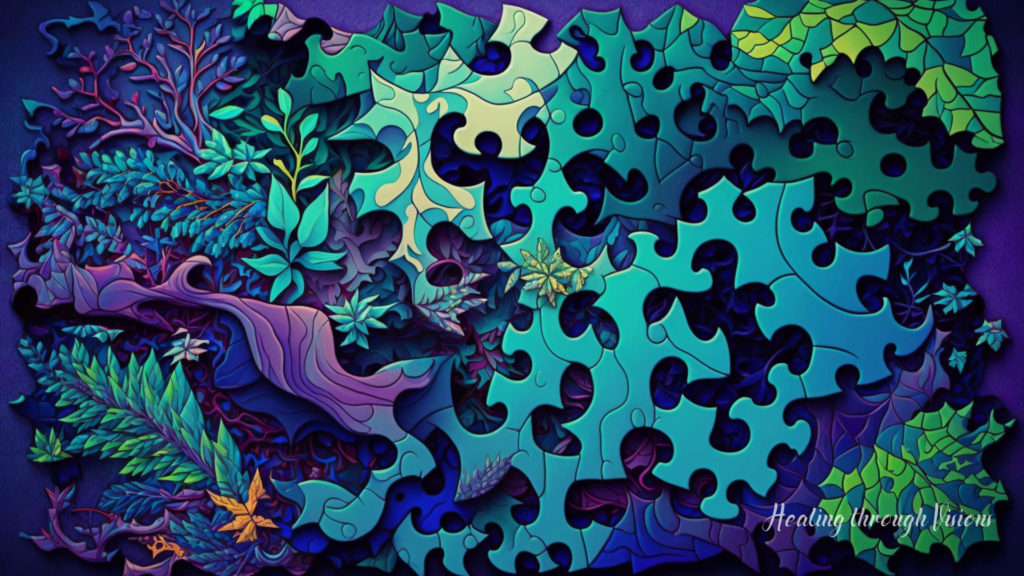Autism Acceptance Month
Embracing Neurodiversity: A Guide to Autism Acceptance Month
April is Autism Acceptance Month, a time to recognize and celebrate the unique perspectives and experiences of those on the autism spectrum. As a Black woman with autism and ADHD, I know firsthand the challenges and joys that come with being neurodistinct. In this article, I want to share my experiences, wisdom, and knowledge to educate and empower others on their own journey of self-discovery and self-acceptance. It is my hope that this article will serve as a source of information, inspiration, and support for all those who are on the autism spectrum or who know and love someone who is.
In recent years, there has been a shift from Autism Awareness Month to Autism Acceptance Month. This change reflects a growing understanding that mere awareness of autism is not enough, and that true acceptance and inclusion are necessary. While awareness campaigns can help spread information and knowledge about autism, they can also promote harmful stereotypes and stigmatization. By focusing on acceptance, we can promote a more positive and inclusive narrative around autism, one that recognizes and celebrates the unique perspectives and experiences of individuals on the spectrum. Acceptance means acknowledging and valuing autistic individuals for who they are, without trying to change or fix them. It means creating a world where autistic individuals are respected, supported, and included in all aspects of society.
Disclaimer
I am not a doctor, and the information in this article is not intended to diagnose, treat, or cure any medical condition. It is based solely on my personal experiences and research, and is intended for educational purposes only. Please consult a healthcare professional for personalized medical advice.
Understanding Autism
Autism is a neurodevelopmental condition that affects communication, social interaction, and sensory processing. It is a complex and multifaceted condition that can manifest in many different ways, making it difficult to define and diagnose. Autism is a spectrum disorder, which means that individuals can experience a wide range of symptoms and severity.
The exact cause of autism is still unknown, but research suggests that it may be the result of a combination of genetic and environmental factors. It is not caused by bad parenting or social factors, as was once believed.
Common signs of autism include difficulties with social cues, repetitive behaviors, sensory sensitivities, and intense interests or obsessions. Some people with autism may have difficulty with eye contact, facial expressions, and body language, which can make social interactions challenging. Others may have difficulty with communication, such as delayed language development, a preference for nonverbal communication, or trouble understanding and using language.
Many individuals with autism also experience sensory sensitivities, which can make certain sounds, textures, or lights overwhelming or painful. This can cause stress and anxiety in everyday situations that others may find routine. Additionally, people with autism may engage in repetitive behaviors or routines, such as lining up objects, rocking back and forth, or repeating words or phrases. These behaviors can be calming or soothing, but can also interfere with daily functioning.
It’s important to remember that every individual with autism is unique and experiences the condition differently. Some people with autism may have exceptional abilities in areas such as art, music, or mathematics, while others may struggle with basic daily tasks. It’s important to focus on the strengths and abilities of individuals with autism, rather than just their challenges.
Understanding autism is an ongoing process. As research and acceptance continue to grow, so too does our understanding of this complex and diverse condition. It is important to approach autism with an open mind, and to seek out information and resources to better understand and support individuals with autism.
The Importance of Autism Acceptance
Autism Acceptance Month plays an essential role in promoting understanding and acceptance of neurodiversity. This month helps individuals recognize the diverse ways that autism presents itself and how it can impact people’s lives. This acceptance leads to improved support, services, and accommodations that help autistic individuals thrive.
One of the significant challenges that autistic individuals face is the stigma associated with their condition. Due to a lack of understanding, some people may view individuals with autism as different or weird. This can lead to bullying, isolation, and discrimination, which can have severe impacts on an individual’s mental health and wellbeing.
Autism Acceptance Month helps to address this issue by promoting acceptance and inclusion. Through awareness, acceptance, campaigns and events, the public can learn about the unique strengths and talents of those on the spectrum. This knowledge can help to reduce stigma and misconceptions and promote more accepting and inclusive attitudes.
Additionally, Autism Acceptance Month provides a platform for autistic individuals and their families to advocate for their rights and needs. It offers an opportunity to raise awareness about the challenges that autistic individuals face and the importance of support and accommodations. This advocacy can lead to better access to healthcare, education, and other essential services that help autistic individuals live fulfilling lives.
Autism Acceptance Month plays a vital role in promoting understanding, acceptance, and advocacy for individuals on the autism spectrum. It offers an opportunity to celebrate diversity, promote inclusivity, and empower autistic individuals to reach their full potential.
My Journey with Autism
As someone who was not diagnosed with autism and ADHD until adulthood, I understand the challenges of living without a diagnosis. I struggled with social interactions, sensory sensitivities, and communication difficulties without understanding why. It wasn’t until I was diagnosed that I could finally make sense of my experiences and find the resources and support I needed.
Growing up, I always felt different from my peers. I experienced difficulty with making friends and often found myself overwhelmed by sensory stimuli. I would become fixated on certain interests, and my family would write it off as a phase or a hobby. Despite my challenges, I excelled academically and went on to earn a degree in a field I was passionate about.
It wasn’t until I was an adult that I received a diagnosis of autism and ADHD. This diagnosis was a turning point in my life, as it allowed me to understand and embrace my neurodistinct identity. It was a relief to finally have an explanation for why I excelled in areas that seem complex to others, and struggled in other areas, especially with finding a community of being who shared similar experiences.
Since my diagnosis, I have worked to educate myself about autism and ADHD, and I have found ways to manage my challenges while celebrating my strengths. I have also become an advocate for neurodiversity and work to promote acceptance and inclusion in all areas of life.
My journey with autism has been a winding one, but I wouldn’t trade it for anything. The journey has made me who I am today, and I am proud of the person I was, am and who I am becoming. I hope that by sharing my story, I can inspire others on their own journey of self-discovery and self-acceptance.
Navigating Neurodiversity as a Black Person
As a Black person with autism, I have experienced the intersection of race and neurodiversity firsthand. Black people, especially Black women, are often overlooked and misdiagnosed in the medical field. This can lead to a lack of understanding of one’s needs and can make it challenging to access appropriate resources and support.
I remember feeling like something was wrong with me, but not being able to articulate what it was. I felt like I didn’t fit in, and that people didn’t understand me. This was compounded by the fact that I often felt like I had to work twice as hard to be seen and heard, due to the pervasive racism and microaggressions in our society.
When it comes to accessing resources and support for neurodiversity, it can be especially challenging for Black individuals. Many mainstream resources are not culturally sensitive or accessible, and can even perpetuate harmful stereotypes and biases. For example, Black children are often more likely to be diagnosed with conduct disorders or ADHD, even when they exhibit symptoms of autism.
It’s important to create safe and inclusive spaces where Black neurodistinct individuals can feel seen, heard, and understood. This includes creating culturally sensitive resources and support networks, and working to reduce the stigma and discrimination that can come with being both Black and neurodistinct.
At Healing through Visions, I am committed to creating a space that is welcoming and inclusive for all individuals, regardless of their race, gender, or neurodiversity. I believe that everyone deserves to feel supported and empowered on their healing journey, and I am passionate about helping individuals tap into their inner wisdom and discover their true potential.
Through my own journey with autism and neurodiversity, I have learned the importance of self-acceptance and self-advocacy. I believe that everyone has the right to be seen and heard, and that our differences should be celebrated and embraced.
Navigating neurodiversity as a Black person can be challenging, but it’s important to remember that you are not alone. There are resources and support networks available, and it’s crucial to create inclusive spaces where all individuals can feel welcome and supported. At Healing through Visions, I am committed to creating such a space and empowering all individuals on their journey of self-discovery and healing.
Tools and Resources for Autistic Individuals
There are many tools and resources available for autistic individuals to support their wellbeing and growth. These resources can help individuals navigate their unique experiences, manage challenges, and celebrate their strengths. It’s essential to find what works best for you and to seek out resources that are tailored to your specific needs and goals.
One essential resource for individuals with autism is therapy. Therapy can provide a safe and supportive space to explore thoughts and emotions, develop coping skills, and improve communication and social skills. There are many types of therapy available, including cognitive-behavioral therapy (CBT), occupational therapy, and speech therapy.
Another valuable resource is assistive technology. Assistive technology can support individuals with autism in their daily lives and help them communicate, learn, and engage with the world around them. Examples of assistive technology include communication apps, sensory tools, and visual aids.
Mindfulness practices can also be helpful for individuals with autism. Mindfulness can help individuals manage anxiety, improve focus and attention, and regulate emotions. Mindfulness can be practiced in many different ways, such as through meditation, yoga, or breathing exercises.
Maintaining a healthy lifestyle is essential for individuals with autism to manage their overall wellbeing. Getting enough sleep, exercise, and proper nutrition can have a significant impact on their physical and mental health. For many individuals with autism, sleep can be challenging due to sensory sensitivities or difficulty regulating their sleep-wake cycle. Therefore, establishing a consistent bedtime routine that includes calming activities such as reading, dimming the lights, and minimizing noise can help improve sleep quality.
Exercise can also be beneficial for individuals with autism. Physical activity can help reduce stress and anxiety while improving physical health. Finding a type of exercise that the individual enjoys, such as swimming, walking, or yoga, can make it easier to stick to a routine. It’s important to note that sensory issues may make some types of exercise more challenging for some individuals with autism. For example, the sounds and smells of a gym can be overwhelming, making outdoor activities a better option.
Eating a well-balanced diet can also have a positive impact on mental and physical health. Some individuals with autism may have a restricted diet due to sensory issues or preferences. In these cases, it’s important to work with a healthcare professional or nutritionist to ensure that the individual is still getting all the necessary nutrients. Staying hydrated is also essential, as dehydration can worsen symptoms of anxiety and irritability.
In addition to these resources, there are many organizations and support groups for individuals with autism and their families. These organizations can provide a sense of community, access to resources and information, and opportunities to advocate for autism acceptance and inclusion. Examples of such organizations include Black Neurodiversity, the Autism Society of America and the Autism Self Advocacy Network.
It’s important to remember that every individual with autism is unique and has different needs and preferences. Finding the right tools and resources may take time and experimentation, but the journey of self-discovery and self-acceptance is worth it. With the right support and resources, individuals with autism can thrive and reach their full potential.
Supporting Individuals with Autism
If you’re a non-Autistic person who wants to support someone with autism, there are many ways you can do so. Here are some tips:
- Educate yourself: Learn more about autism and the experiences of people on the spectrum. This can help you understand and empathize with your loved one’s perspective.
- Listen: Ask your loved one how they’re feeling and what they need. Everyone on the spectrum is different, so what works for one person may not work for another.
- Be patient: Communication and social interaction can be challenging for people with autism. Give your loved one time and space to express themselves in their own way.
- Respect boundaries: Some individuals with autism may have specific sensory needs or preferences. Ask your loved one about their boundaries and respect them.
- Celebrate strengths: People with autism have many unique strengths and talents. Celebrate and encourage your loved one’s abilities and interests.
- Provide support: If your loved one needs additional support, such as therapy or other services, help them find and access those resources.
Taking these steps can help create a supportive and inclusive environment for individuals with autism. Remember that everyone on the spectrum is different, so it’s important to be flexible and responsive to each individual’s needs and preferences.
On the Use of Puzzle Pieces in Depicting Autism
As a practitioner and writer, my intention is to create content that is respectful and inclusive of all communities. I recently learned that the puzzle piece has been criticized by members of the autism community. Prior to this knowledge, I chose to use it in the image for this article as a surrealistic depiction of puzzle pieces coming together to form wholeness. I recognize and respect the opinions and feelings of those who have negative associations with the puzzle piece. As we strive to create a more accepting and inclusive world for all neurodistinct individuals, it’s important that we listen to and learn from each other, and work together to create a better future for all.
Moving forward, I will be using the infinity symbol as the inclusive and positive representation of the autistic community. This symbol is gaining popularity in the community as it represents the idea that there is nothing missing or broken, and that individuals on the spectrum are whole and complete just as they are.
For those who would like more background on the puzzle piece symbol and the controversy surrounding it, I encourage you to read this article (https://www.123shoot.com/nothing-missing-why-the-puzzle-piece-isnt-used-in-autism-acceptance/). If you have any questions or concerns, please feel free to leave a comment on this article or send me a message.
Final Thoughts
Autism Acceptance Month is a significant milestone in our collective journey towards understanding and embracing neurodiversity. By shifting our focus from awareness to acceptance, we can begin to recognize the unique perspectives and experiences of those on the autism spectrum. As a society, we can support their right to live their lives fully and authentically. It’s crucial that we continue to educate ourselves and others about autism, reduce stigma, and promote acceptance and inclusion for all individuals, regardless of their neurodivergence. As a neurodistinct Black woman, I am passionate about advocating for and empowering others on their journey of self-discovery and self-acceptance. Let’s work together to create a world that values and embraces the diversity of human experience.


